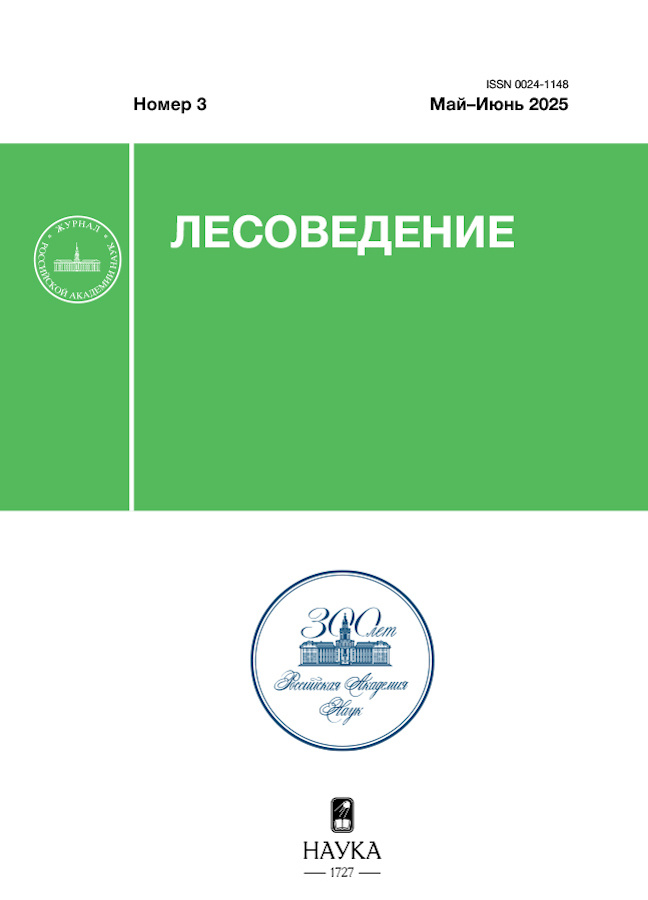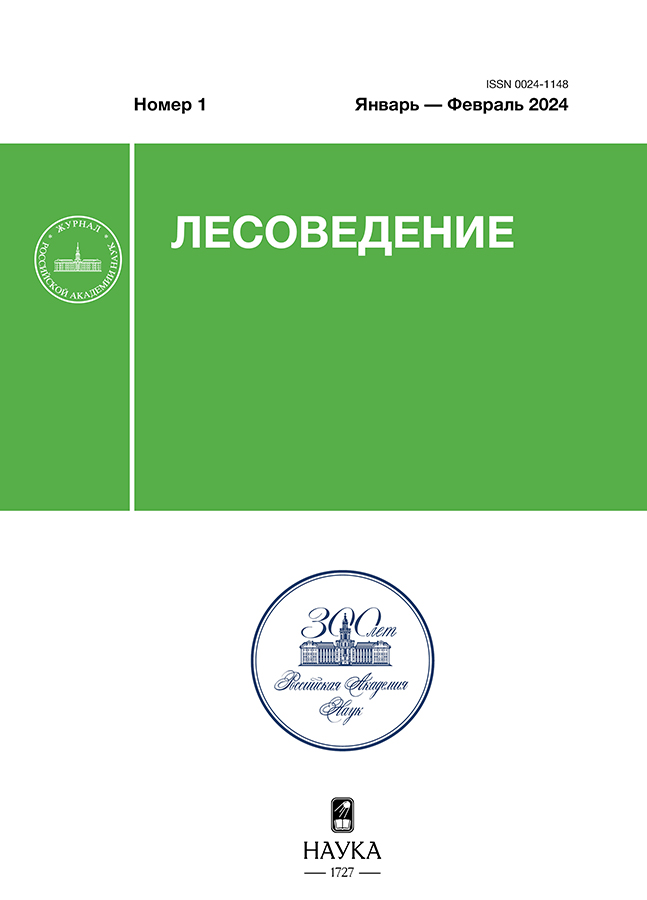Рост и структурные особенности хвои пихты сибирской на северо-востоке Европейской части России
- Авторы: Герлинг Н.В.1, Тарасов С.И.1
-
Учреждения:
- Институт биологии Коми НЦ УрО РАН
- Выпуск: № 6 (2023)
- Страницы: 596-607
- Раздел: ОРИГИНАЛЬНЫЕ СТАТЬИ
- URL: https://permmedjournal.ru/0024-1148/article/view/674058
- DOI: https://doi.org/10.31857/S0024114823060037
- EDN: https://elibrary.ru/EHVLVX
- ID: 674058
Цитировать
Полный текст
Аннотация
Пихта сибирская (Abies sibirica Ledeb.) – объект настоящих исследований – наименее изученная лесообразующая порода на северо-востоке Европейской части России. Цель работы – изучение изменений структуры хвои пихты в процессе ее роста. В работе на основе модели роста рассматривается связь линейных размеров хвои пихты сибирской с изменениями анатомической структуры и ультраструктуры ее ассимиляционного аппарата в период внепочечного роста. В качестве модели роста или модели изменения линейных размеров (длины, ширины и толщины) хвои пихты сибирской была успешно апробирована логистическая модель, которая показала себя как удобный инструмент анализа процессов развития хвои на всех структурных уровнях. Применение модели позволяет выделить фазы развития хвои и установить синхронность изменений линейных размеров хвои с развитием ассимиляционных клеток. Показано, что при выходе из почки хвоя пихты сибирской качественно уже способна к фотосинтезу, о чем свидетельствует наличие развитых тилакоидов и гран в хлоропластах, а также фотосинтетических пигментов. Наибольшего своего качественного и количественного развития ассимиляционный аппарат достигает после окончания последней фазы роста хвои в длину, что дает основание заключить: при оптимальных условиях окружающей среды уже развитая хвоя достигает в этот период наибольшей функциональной активности.
Ключевые слова
Об авторах
Н. В. Герлинг
Институт биологии Коми НЦ УрО РАН
Автор, ответственный за переписку.
Email: Gerling1@rambler.ru
Россия, 167982, Сыктывкар, ул. Коммунистическая, д. 26
С. И. Тарасов
Институт биологии Коми НЦ УрО РАН
Email: Gerling1@rambler.ru
Россия, 167982, Сыктывкар, ул. Коммунистическая, д. 26
Список литературы
- Атлас ультраструктуры растительных тканей / Под ред. М.Ф. Даниловой, Г.М. Козубова. Петрозаводск: Карелия, 1980. 455 с.
- Загирова С.В. Рост побегов и динамика структуры клеток мезофилла в двухлетней хвое Abies sibirica Ledeb. // Физиология растений. 2003. Т. 50. № 1. С. 43–47.
- Исаев А.С., Суховольский В.Г., Хлебопрос Р.Г., Бузыкин А.И., Овчинникова Т.М. Моделирование лесообразовательного процесса: феноменологический подход // Лесоведение. 2005. № 1. С. 3–11.
- Козина Л.В. Метаболизм фотоассимилятов и передвижение веществ у хвойных. Владивосток: Дальнаука, 1995. 129 с.
- Коренные еловые леса Севера: биоразнообразие, структура, функции / Под ред. К.С. Бобковой и Э.П. Галенко. СПб.: Наука, 2006. 337 с.
- Ладанова Н.В., Тужилкина В.В. Структурная организация и фотосинтетическая активность хвои ели сибирской. Сыктывкар: Коми НЦ УрО РАН, 1992. 100 с.
- Маслова Т.Г., Попова И.А., Попова О.Ф. Критическая оценка спектрофотометрического метода количественного определения каротиноидов // Физиология растений. 1986. Т. 33. С. 615–619.
- Мокроносов А.Т., Багаутдинов Р.И., Бубнова Е.А., Кобелева И.В. Фотосинтетический метаболизм в палисадной и губчатой тканях листа // Физиология растений. 1973. Т. 20. Вып. 6. С. 1191–1197.
- Молчанов А.А., Смирнов В.В. Методика изучения прироста древесных растений. М.: Наука, 1967. 95 с.
- Пихта / Под ред. Крылова Г.В., Марадудина И.И., Михеева Н.И., Козаковой Н.Ф. М.: Агропромиздат, 1986. 239 с.
- Робакидзе Е.А., Патов А.И. Рост хвои ели сибирской в зависимости от экологических факторов // Лесной журн. 2011. С. 7–14.
- Скупченко В.Б. Клеточный рост основной паренхимы стебля в морфогенезе побега Piceа abies (Pinaceae) // Растительные ресурсы. 2019. Т. 55. № 2. С. 195–212.
- Скупченко В.Б. Морфогенез и рост вегетативного побега Pseudotsuga menziesii (Pinaceae), интродуцированной в Санкт-Петербурге // Растительные ресурсы. 2022. Т. 58. № 1. С. 43–57.
- Скупченко В.Б. Морфометрия на экране электронного микроскопа // Ботанический журнал. 1990. Т. 75. № 10. С. 1463–1467.
- Титова М.С. Содержание фотосинтетических пигментов в хвое Picea abies и Picea koraiensis // Вестник ОГУ. 2010. № 12 (118). С. 9–12.
- Ходасевич Э.В. Фотосинтетический аппарат хвойных: онтогенетический аспект. Минск: Наука и техника, 1982. 199 с.
- Цельникер Ю.Л. Физиологические основы теневыносливости древесных растений. М.: Наука, 1978. 212 с.
- Юдин Ю.П. Темнохвойные леса // Производительные силы Коми АССР. М.–Л. Ч. 1. Растительный мир. 1954. С. 42–126.
- Andersson Gull B., Persson T., Fedorkov A., Mullin T.J. Longitudinal differences in Scots pine shoot elongation // Silva Fennica. 2018. V. 52. № 5. P. 1–12. https://doi.org/10.14214/sf.10040
- Koya P.R., Goshu A.T. Generalized Mathematical Model for Biological Growths // Open Journal of Modelling and Simulation. 2013. V. 1. № 4. P. 42–53. http://www.scirp. org/journal/ojmsi
- Kucharavy D., De Guio R. Application of logistic growth curve // Procedia Engineering. 2015. № 131. P. 280–290.
- Lichtenthaler H.K. Chlorophylls and carotenoids: Pigments of photosynthetic biomembranes // Methods in Enzymology. San Diego: Academic Press, 1987. P. 350–382.
- Monteith J.L. Fundamental equations for growth in uniform stands of vegetation // Agricultural and Forest Meteorology. 2000. V. 104. № 1. P. 5–113.
- Owens J.N. Initiation and development of leaves in Douglas-fir // Canadian Journal of Botany. 1968. V. 46. P. 271–278.
- Weiskittel A.R., Hann D.W., Kershaw J.A., Vanclay J.K. Forest growth and yield modeling. John Wiley & Sons. 2011. 415 p.
Дополнительные файлы
















